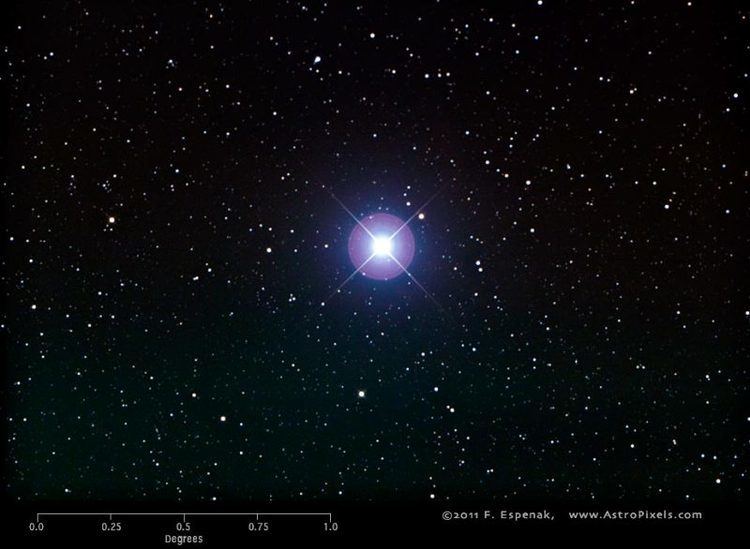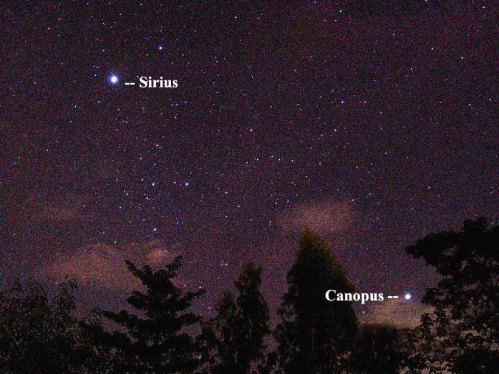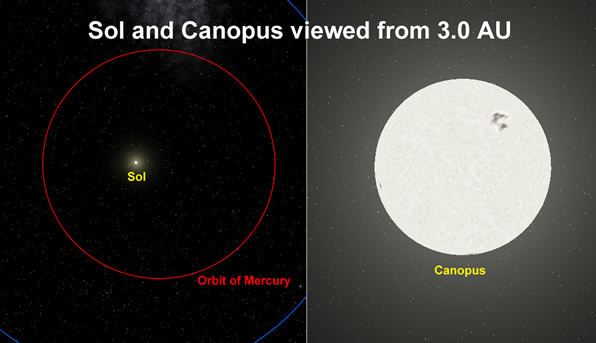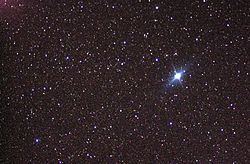Surface temperature 7,350 K Mass 1.949 × 10^31 kg (9.8 M☉) Apparent magnitude (V) -0.72 | Magnitude -0.72 | |
 | ||
Radius 49.69 million km (71.4 R☉) Similar | ||
Canopus (/kəˈnoʊpəs/), also designated Alpha Carinae (α Carinae, abbreviated Alpha Car, α Car), is the brightest star in the southern constellation of Carina, and the second brightest star in the night-time sky, after Sirius. Canopus's visual magnitude is −0.74, and it has an absolute magnitude of −5.71.
Contents
- Superstar canopus shining
- Observational history
- Visibility
- Properties
- Etymology and cultural significance
- Africa
- Americas
- Asia
- Australia
- Middle East
- Polynesia
- Role in navigation
- Modern legacy
- References

Canopus is a bright giant of spectral type A9, so it is essentially white when seen with the naked eye. It is located in the far southern sky, at a year 2000 declination of −52° 42′ and a right ascension of 06h 24.0m.

Its name is generally considered to originate from the mythological Canopus, who was a navigator for Menelaus, king of Sparta (see below).

Superstar canopus shining
Observational history

In Indian Vedic literature, the star Canopus is associated with the sage Agastya, one of the ancient rishis (the others are associated with the stars of the Big Dipper). Agastya, the star, is said to be the 'cleanser of waters' and its rising coincides with the calming of the waters of the Indian Ocean. It is considered the son of Pulasthya, son of Brahma.

Canopus was not visible to the mainland ancient Greeks and Romans; it was, however, visible to the ancient Egyptians. Hence Aratus did not write of the star as it remained below the horizon, while Eratosthenes and Ptolemy—observing from Alexandria—did, calling it Kanōbos.
The Navajo named it Ma’ii Bizò‘.

The Bedouin people of the Negev and Sinai also knew it as Suhayl, and used it and Polaris as the two principal stars for navigation at night. Due to the fact that it disappears below the horizon in those regions, it became associated with a changeable nature, as opposed to always-visible Polaris, which was circumpolar and hence 'steadfast'. It is also referred to by its Arabic name: سهيل (Suhayl, Soheil in Persian), given by Islamic scientists in the 7th century AD.

Called the Old Man of the South Pole (in Chinese: 南极老人; pinyin: Nanji Lǎorén) in Chinese, Canopus appears (albeit misplaced northwards) on the medieval Chinese manuscript the Dunhuang star chart, despite not being visible from the Chinese capital of Chang'an. The Chinese astronomer Yi Xing had journeyed south to chart Canopus and other far southern stars in 724 AD. However, it was already mentioned by Sima Qian in the second century BC, drawing on sources from the Warring States period, as the southern counterpart of Sirius.
Bright stars were important to the ancient Polynesians for navigation between the many islands and atolls of the Pacific Ocean. Low on the horizon, they acted as stellar compasses to assist mariners in charting courses to particular destinations. Canopus served as the southern wingtip of a "Great Bird" constellation called Manu, with Sirius as the body and Procyon the northern wingtip, which divided the Polynesian night sky into two hemispheres. The Hawaiian people called Canopus Ke Alii-o-kona-i-ka-lewa, "The chief of the southern expanse"; it was one of the stars used by Hawaii-loa and Ki when they traveled to the Southern Ocean.
The Māori people of New Zealand/Aotearoa had several different names for Canopus. Ariki ("High-born"), was known as a solitary star that appeared in the east, prompting people to weep and chant. They also named it Atutahi, Aotahi or Atuatahi, "Stand Alone". Its solitary nature indicates it is a tapu star, as tapu people are often solitary. Its appearance at the beginning of the Maruaroa season foretells the coming winter; light rays to the south indicate a cold wet winter, and to the north foretell a mild winter. Food was offered to the star on its appearance. This name has several different mythologies attached to it as well. One story tells of how Atutahi was left outside of the basket representing the Milky Way when Tāne wove it. Another related myth surrounding the star says that Atutahi was the first-born child of Rangi, who refused to enter the Milky Way and so turned it sideways and rose before it. The same name is used for other stars and constellations throughout Polynesia. Kapae-poto, "Short horizon", referred to the fact that it rarely sets from the vantage point of New Zealand; Kauanga ("Solitary") was the name for Canopus only when it was the last star visible before sunrise.
The Tswana people of Botswana knew Canopus as Naka. Appearing late in winter skies, it heralded increasing winds and a time when trees lose their leaves. Stock owners knew it was time to their sheep with rams. To the ǀXam-speaking Bushmen of South Africa, Canopus and Sirius signalled the appearance of termites and flying ants. They also believed stars had the power to cause death and misfortune, and they would pray to Sirius and Canopus in particular to impart good fortune or skill.
The Kalapalo people of Mato Grosso state in Brazil saw Canopus and Procyon as Kofongo "Duck", with Castor and Pollux representing his hands. The asterism's appearance signified the coming of the rainy season and increase in manioc, a food staple fed to guests at feasts.
Canopus traditionally marked the rudder of the ship Argo Navis. English explorer Robert Hues brought it to the attention of European observers in his 1592 work Tractatus de Globis, along with Achernar and Alpha Centauri, noting "Now, therefore, there are but three Stars of the first magnitude that I could perceive in all those parts which are never seene here in England. The first of these is that bright Star in the sterne of Argo which they call Canobus. The second is in the end of Eridanus. The third is in the right foote of the Centaure."
Visibility
In the southern hemisphere, Canopus and Sirius are both visible high in the sky simultaneously, and reach the meridian just 21 minutes apart. Brighter than first magnitude, Canopus can be seen by naked eye already in the early twilight. Most visible in the southern hemisphere summer, Canopus culminates at midnight on December 27, and at 9PM on February 11.
It is a circumpolar star when seen from points that have latitude south of 37°18' S; for example, Victoria and Tasmania, Australia; Auckland and south of it, New Zealand; Bahía Blanca, Argentina; and Valdivia, Chile and south of these cities in South America. Since Canopus is so far south in the sky, it never rises in mid- or far-northern latitudes; in theory the northern limit of visibility is latitude 37°18' north. This is just south of Athens, Richmond (USA), and San Francisco, and very close to Seville and Agrigento. It is almost exactly the latitude of Lick Observatory on Mt. Hamilton, California, from which it is readily visible because of the effects of elevation and atmospheric refraction, which add another degree to its apparent altitude. Under ideal conditions it has been spotted as far north as latitude 37°31' from the Pacific coast. Another northernmost record of visibility came from Mount Nemrut in Turkey, latitude 37°59'. It is more easily visible in places such as the Gulf Coast and Florida, and the island of Crete (Greece) where the best season for viewing it around 9 p.m. is during late January and early February.
Canopus has a B-V color index of +0.15 where 0 is a blue-white, indicating it is essentially white, although has been described as yellow-white. Its spectral type has been recorded as F0 and more recently A9. It has less yellow than Altair or Procyon, whose color indexes have been measured at 0.22 and 0.42 respectively. It may be that some observers have perceived it as yellow-tinged owing to its being located low in the sky and hence subject to atmospheric effects.
Properties
Before the launch of the Hipparcos satellite telescope, distance estimates for Canopus varied widely, from 96 light years to 1200 light years. Had the latter distance been correct, Canopus would have been one of the most luminous stars in the Milky Way galaxy. Hipparcos established Canopus as lying 310 light years (96 parsecs) from the Solar System; this is based on its 2007 parallax measurement of 10.43 ± 0.53 mas.
Canopus has an MK spectral type of A9 II, although it has also been classified as F0Ib (Ib referring to "less luminous supergiant") on account of its high luminosity, or F0II. The effective temperature of Canopus has been measured to be 6,998 K. Very long baseline interferometry has been used to calculate its angular diameter at 6.9 mas. Combined with distance calculated by Hipparcos, this gives it a radius of 71 R☉. If it were placed at the centre of the Solar System, it would extend 90% of the way to the orbit of Mercury. It is over ten thousand times more luminous than the sun.
Canopus is a source of X-rays, which are probably produced by its corona, magnetically heated to several million K. The temperature has likely been stimulated by fast rotation combined with strong convection percolating through the star's outer layers.
Canopus is the most intrinsically bright star within approximately 700 light years, and it has been the brightest star in Earth's sky during three different epochs over the past four million years. Other stars appear brighter only during relatively temporary periods, during which they are passing the Solar System at a much closer distance than Canopus. About 90,000 years ago, Sirius moved close enough that it became brighter than Canopus, and that will remain the case for another 210,000 years. But in 480,000 years, Canopus will once again be the brightest, and will remain so for a period of about 510,000 years.
Canopus was previously claimed to be a member of the Scorpius-Centaurus Association, however it is not located near the subgroups of that association, and has not been included as a Sco-Cen member in kinematic studies that used Hipparcos astrometric data. At present, Canopus is not thought to be a member of any nearby young stellar groups. Its position in the H-R diagram indicates that it is a massive giant star currently in the core-helium burning phase.
In 2014, astronomer Eric Mamajek reported that an extremely magnetically active M dwarf (having strong coronal X-ray emission), situated 1.16 degrees south of Canopus, appears to share common proper motion with the bright star. The projected separation of the M dwarf 2MASS J06234738-5351131 ("Canopus B") is approximately 1.9 parsecs, however despite this large separation, it is still within the estimated tidal radius (2.9 parsecs) for the massive star Canopus.
Etymology and cultural significance
α Carinae (Latinised to Alpha Carinae) is the star's Bayer designation.
The name Canopus is a Latinisation of the Ancient Greek name Κάνωβος/Kanôbos, recorded in Claudius Ptolemy's Almagest (c150 AD). Eratosthenes used the same spelling. Hipparchos wrote it as Κάνωπος. John Flamsteed wrote Canobus, as did Edmond Halley in his 1679 Catalogus Stellarum Australium. The name has two common derivations, both listed in Richard Hinckley Allen's seminal Star Names: Their Lore and Meaning; and one which is less common. All are matters of conjecture:
In 2016, the International Astronomical Union organized a Working Group on Star Names (WGSN) to catalog and standardize proper names for stars. The WGSN's first bulletin of July 2016 included a table of the first two batches of names approved by the WGSN; which included Canopus for this star. It is now so entered in the IAU Catalog of Star Names.
Africa
An Egyptian priestly poet in the time of Thutmose III mentions the star as Karbana, "the star which pours his light in a glance of fire, When he disperses the morning dew."
Under the Ptolemies, the star was known as Ptolemaion (Greek: Πτολεμαῖον) and its acronychal rising marked the date of the Ptolemaia festival, which was held every four years, from 262 to 145 BC.
In the traditional Xhosa calendar, May is named UCanzibe (the month of Canopus).
Americas
The Navajo observed the star and named it Ma’ii Bizò‘.
Asia
It is also personified as the Shou star.
In Japan, Canopus is known as Mera-boshi and Roujin-sei (the old man star).
In Ancient Hindu astronomy and astrology, Canopus is named Agasti or Agastya.
In traditional Tibetan astronomy and astrology, Canopus is named Karma Rishi སྐར་མ་རི་ཥི།
Kalīla o Damna, an influential Pahlavi (Middle Persian) book of animal fables was later known as Anvar-i-Suhayli or The Lights of Canopus.
Australia
Canopus was identified as the moiety ancestor Waa "Crow" to some Koori people in southeastern Australia. The Boorong people of northwestern Victoria recalled that War (Canopus) was the brother of Warepil (Sirius), and that he brought fire from the heavens and introduced it to mankind. His wife was Collowgullouric War (Eta Carinae). The Pirt-Kopan-noot people of western Victoria told of Waa "Crow" falling in love with a queen, Gneeanggar "Wedge-tailed Eagle" (Sirius) and her six attendants (the Pleiades). His advances spurned, he hears that the women are foraging for grubs and so transforms himself into a grub. When the women dig him out, he changes into a giant and carries her off.
The Kulin people knew Canopus as Lo-an-tuka. Objects in the sky were also associated with states of being for some tribes; the Wailwun of northern New South Wales knew Canopus as Wumba "deaf", alongside Mars as Gumba "fat" and Venus as Ngindigindoer "you are laughing". Tasmanian aboriginal lore held that Canopus was Dromerdene, the brother of Moinee; the two fought and fell out of the sky, with Dromerdene falling into Louisa Bay in southwest Tasmania.
Middle East
Canopus was known to the ancient Mesopotamians and given the name NUN-ki and represented the city of Eridu in the Three Stars Each Babylonian star catalogues and later MUL.APIN around 1100 BC. Today, the star Sigma Sagittarii is known by the common name Nunki.
An occasional name seen in English is Soheil, or the feminine Soheila; in Turkish is Süheyl, or the feminine Süheyla, from the Arabic name for several bright stars, سهيل suhayl, and Canopus was known as Suhel in medieval times. Alternate spellings include Suhail, Suhilon, Suheyl, Sohayl, Suhayil, Shoel, Sohil, Soheil, Sahil, Suhayeel, Sohayil, Sihel, and Sihil. An alternate name was Wazn "weight" or Haḍar "ground", possibly related to its low position near the horizon. Hence comes its name in the Alphonsine Tables, Suhel ponderosus, a Latinization of Al Suhayl al Wazn. Its Greek name was revived during the Renaissance.
Polynesia
The people of the Society Islands had two names for Canopus, as did the Tuamotu people. The Society Islanders called Canopus Taurua-e-tupu-tai-nanu, "Festivity-whence-comes-the-flux-of-the-sea", and Taurua-nui-o-te-hiti-apatoa "Great-festivity-of-the-border-of-the-south", and the Tuamotu people called the star Te Tau-rari and Marere-te-tavahi, the latter said to be the true name for the former, "He-who-stands-alone".
Among New Zealand Maori Canopus is a circumpolar star called Atutahi (variants include Autahi and Aotahi). Atutahi was considered so sacred that he stood alone outside the Milky Way, it was an important weather predictor and indicated when soils were ready for planting. Te Taki o Atutahi referred to the stars role in leading Te Punga (the anchor) i.e. the Southern Cross.
Role in navigation
To anyone living in the northern hemisphere, but far enough south to see the star, it served as a southern pole star. This lasted only until magnetic compasses became common.
In modern times, Canopus serves another navigational use. Canopus's brightness and location well off the ecliptic make it popular for space navigation. Many spacecraft carry a special camera known as a "Canopus Star Tracker" plus a Sun sensor for attitude determination.
The effects of precession will take Canopus within 10° of the south celestial pole around the year 14,000 CE.
Modern legacy
Canopus appears on the flag of Brazil, symbolising the state of Goiás.
Two U.S. Navy submarine tenders have been named after Canopus, the first serving from 1922 to 1942 and the second serving from 1965 to 1994.
